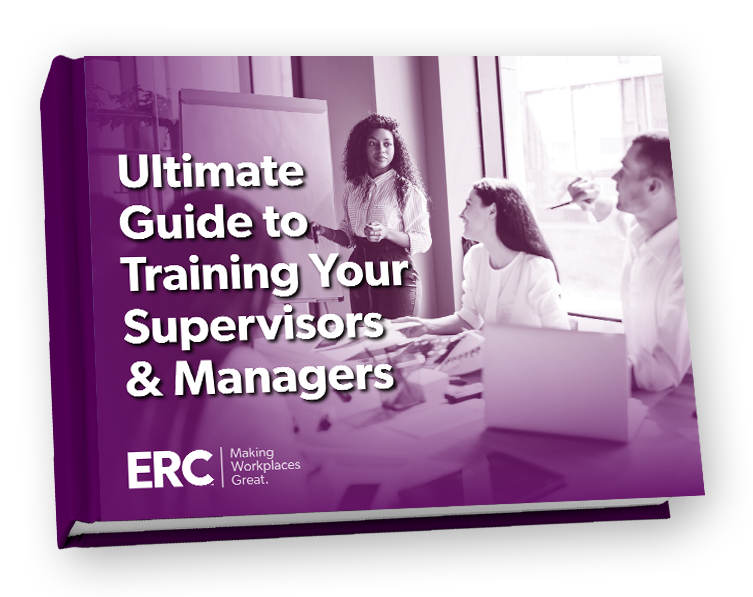

The Ultimate Guide to Training Your Supervisors and Managers
This ultimate guide shares how training your supervisors and managers will help them overcome challenges, motivate those around them, and be more effective in their roles.

Don’t have time to read the entire ultimate guide right now?
We are happy to email you the complete guide so you can read it when it’s convenient for you.
Introduction
Research shows that over half of new supervisors and managers receive little or no training before assuming their new roles.
The practice is common in many organizations because the typical assumption is that high performing individual contributors will transition easily from managing projects and processes to managing people. But managing people requires an incredibly different and unique skill set. As a result, imagine how that lack of training and preparation can negatively impact the individual, the team, and ultimately, the organization.
So instead, imagine how an investment in your supervisors and managers (from those recently promoted to those who have been in their roles for years), in building their skills to manage people, purpose, and performance, and in setting them up for success (versus failure) can positively impact the individual, the team, the organization, and ultimately, your organization’s future.
Looking to train your supervisors?
ERC delivers leadership training to companies nationwide both virtually and in person at your organization or location of choice.
SECTION 1
The Importance of Training Supervisors and Managers
Supervisors and managers in every organization, on any given day, experience successes and face challenges. As a result, it is essential that they have a strong and effective skill set in order to both drive these successes and tackle these challenges. And while there are countless organizational benefits to training supervisors and managers, it is critical to consider the pitfalls of not training supervisors that can put your organization at greater risk.

Pitfall 1: Exposing the organization to liabilities
Organizations are exposed to liabilities when their supervisors and managers aren’t knowledgeable about current employment laws or don’t understand how to apply legal guidelines when interviewing candidates.
For example, supervisors may make selection decisions based on non-job related criteria or subjective biases or ask inappropriate interview questions that could out the organization at risk.
Ask these key questions:
- Are supervisors and managers knowledgeable about employment laws in order to successfully apply legal guidelines in the workplace?
- Do supervisors and managers ask appropriate interview questions?
- Do supervisors and managers participate in making legal selection decisions based on job-related factors and qualifications and not based on any protected-class criteria?
- Do supervisors and managers understand wage and hour law (FLSA) and how it affects the pay of their employees?
- Do supervisors and managers consistently discipline or handle issues related to employee conduct?
- Do supervisors and managers understand the basics of managing employee leave?

Pitfall 2: Failing to document and manage performance
Performance management is a common struggle for many supervisors and managers. Oftentimes, we find that they aren’t doing enough to support the employee in achieving their performance expectations or standards and not providing regular feedback, counseling, and coaching. Correctly documenting performance is commonly overlooked as well.
Ask these key questions:
- Do supervisors and managers generally have a high performance work team, or do their employees struggle in reaching certain performance standards or goals?
- Are employees aware of what is expected of them in terms of performance? Do supervisors and managers communicate these expectations to employees?
- Do supervisors and managers take the performance review process seriously? Do they understand its importance and how to prepare for and deliver a performance review?
- Do supervisors and managers document any and all incidents of poor performance? (note: this is also a potential liability)
- Do supervisors and managers guide performance through regular feedback and coaching?
- Do supervisors and managers support performance with development and training if needed?
- Do supervisors and managers have conversations with employees about their career aspirations and developmental interests? Do they follow-up on insights obtained in these conversations?
- Do supervisors and managers continually challenge and empower their employees?
- Do supervisors and managers make themselves available to answer employee questions about projects, assignments, and tasks?
- Do supervisors and managers recognize and thank employees for their contributions when they do a good job?
- Do supervisors and managers criticize more than they praise? Is there an imbalance of negative and positive feedback, and is this justified?

Pitfall 3: Poor communication skills
Inadequate communication manifests itself in a number of problems including poor relationships with employees, frequent misunderstandings of job-tasks, unclear expectations, or lack or communicating policies.
These issues often surface from poor listening, lack of relationship-building, and ineffective feedback skills that lead to frequent supervisory problems.
Ask these key questions:
- Do supervisors and managers establish rapport and positive relationships with employees?
- Do supervisors and managers engage in frequent methods of in-person communication?
- Do supervisors and managers actively listen to employees’ concerns, problems, and questions?
- Do supervisors and managers clarify points and issues, trying to better understand work problems employees have?
- Do supervisors and managers ask for employees’ viewpoints and opinions?
- Do supervisors and managers exhibit effective non-verbal communication with employees? Do their words match their body language and tone of voice?
- Do employees often feel confused when completing work assignments, or do misunderstandings frequently occur?
- Do employees receive enough performance feedback from supervisors and managers? Do they understand where they excel and where they need to improve?
- Is the feedback provided by supervisors and managers constructive and well-targeted at behavioral changes?

Pitfall 4: Failing to resolve conflict
Many managers fail to resolve conflict. They may not have the proper set of skills to recognize conflict or know how to minimize negative conflict. It’s not uncommon for supervisors and managers to avoid conflict altogether. As a result, unresolved conflict can potentially escalate into an at-risk employment situation.
Ask these key questions:
- Do supervisors and managers work to accurately define and identify key workplace conflicts, or are problems frequently incorrectly identified?
- Do supervisors and managers recognize the causes of conflict?
- Do supervisors and managers understand the costs of conflict on your business and recognize its effects on productivity?
- Do conflicts generally go unresolved by supervisors and managers, or do supervisors and managers practice different strategies to manage and resolve conflict, ensuring that it has a limited effect on performance?
- Do supervisors and managers frequently collaborate and strive for “win-win” approaches to conflict?
- Do supervisors and managers try to prevent negative conflict by encouraging positive coworker relationships, encouraging recognition of individual differences, and addressing work problems quickly before they escalate?
- Do supervisors try to adapt to different personalities and styles in order to maximize their effectiveness?

Pitfall 5: Not understanding the new role
Typically promoted from individual contributor roles, supervisors and managers find themselves not understanding the new requirements and expectations of their new role. Consequently, that lack of understanding can lead to performance problems for the supervisor or manager.
Ask these key questions:
- Do supervisors and managers frequently encounter challenges on the job in dealing with employee issues and problems?
- Do supervisors and managers understand how their role is different than that of their previous role as an individual contributor? Do they understand its importance in driving results through others?
- Do supervisors and managers understand the responsibilities of their role and how to carry them out?
- Do supervisors and managers make time for employees, balancing task completion and building supportive relationships?
- Do supervisors and managers show trust and confidence in employees?
- Are employees excessively directed and micromanaged?
- Are employees treated with respect and courtesy?
If the supervisors and managers in your organization succumb to one or more of these pitfalls, there are a number of ways to develop them: training, skills coaching & mentoring, and educational materials.
Looking to train your supervisors?
ERC delivers leadership training to companies nationwide both virtually and in person at your organization or location of choice.
SECTION 2
Common Challenges Supervisors Face
Regardless of industry, geographic region, organization size, supervisors and managers in every organization face very common challenges. Why? Because supervisors and managers have to lead people AND policy. It is the art and science of supervising and managing, and it can be a tough balance to maintain.

Challenge 1: Communication
Managers may not be completely aware of their communication style and how the quality of their communications affect and are perceived by their employees.
In order to be successful, it’s crucial for your supervisors and managers to be aware of and understand their unique communication and interpersonal styles. Being aware of one’s own style, as well as being familiar with other styles, helps supervisors use their styles more effectively across different situations.
Try providing your supervisors and managers with communication templates, scripts, tips, or checklists. Engage in role-play or dialogue with the supervisor to help them practice their skills and identify opportunities for improvement.
You can also educate supervisors and managers on common communication breakdowns, how to spot signs of typical communication problems, such as misunderstandings, lack of communication, etc., and how to avoid them or address them when necessary.
Another option you have is to provide a personal coach if communication problems persist within your organization.

Challenge 2: Conflict Resolution
Ineffective supervisors and managers ignore problems and don’t effectively or directly address conflicts with their employees or team.
These problems may include performance problems, conflicts among team members, and issues of trust or personality clashes, just to name a few
Managers are challenged to confront and address conflicts directly and as they emerge, diffuse employees’ feelings and emotions regarding the problem, listen to both parties’ needs and desires, derive win-win solutions that lead to more productive, effective and positive work relations, and minimize conflict in the future by nurturing positive coworker relationships and recognizing potential for conflict or problems early.

Challenge 3: Performance Management
Supervisors must balance meeting goals, managing workloads, and motivating employees. These responsibilities paired with the fact that many supervisors are ill-equipped to provide documented, regular, and constructive feedback, can make performance challenging.
- Build on-going performance feedback into the performance management process to ensure accountability with your supervisors/managers and their employees.
- Create an easy method for supervisors/managers to document performance like a database, software system, log, or diary.
- Provide support tools for supervisors/managers to use to help them build and recognize the importance of performance management such as rewards, or training and development.
- Most importantly, train supervisors/managers on topics such as performance management, coaching, and feedback since many won’t have prior experience with these.

Challenge 4: Compliance
Most supervisors and managers are not well-versed in administering ADA, FMLA, and other laws that protect certain groups of employees (because that’s HR’s job, right?). However, most also find themselves managing an employee who requires an accommodation, a leave of absence or a special circumstance because of a protected class situation.
These situations need to be handled delicately due to their legal nature, so ensure your supervisors are aware of:
- Legal basics such as conditions or disabilities that are protected.
- How to determine essential functions and reasonable accommodations.
- Requirements associated with FMLA (eligibility, length of time, etc.)
- Types of employees that are protected under law (gender, race, nationality, etc.)
- Hiring and interviewing liabilities (questions to ask/not ask, etc.)

Challenge 5: Policy Administration
One of the most common challenges for supervisors and managers is treating employees fairly and consistently. A supervisor may apply policies and rules to some employees but not others, or may disregard employment policies altogether. This type of behavior opens up potential liabilities and perceptions of bias or favoritism that may negatively affect the workplace.
Make sure your organization’s policies are clear and understood by supervisors and managers. Whenever a change in policy occurs, be sure to make them aware.
Set clear criteria for making employment decisions and clearly differentiate between the policies that supervisors and managers have discretion to implement and those they don’t.

Don’t have time to read the entire ultimate guide right now?
We are happy to email you the complete guide so you can read it when it’s convenient for you.
SECTION 3
Preparing New Supervisors
In addition to the common challenges faced by supervisors and managers, those who are newly promoted encounter a unique set of issues.
For many, transitioning into a supervisory or managerial position can be a difficult, yet exciting experience. There are plenty of opportunities and challenges during this process, and it is the organization’s role to ensure the transition goes as smoothly as possible.
Discover the challenges that arise for organizations during the transition process and how to address them:

Tip 1: The Announcement
Often times the transition from an employee to a supervisor or manager ruffles some feathers. If another employee was up for the promotion, feelings may be hurt. Other employees may also react emotionally. Having the new supervisor or manager send an email on their own behalf stating they are “the boss” now may trigger issues in establishing their new authority.
How to address it:
Make sure your organization has a process in place for announcing personnel changes. The Harvard Business Review notes that when an organization has a good process for addressing the transition, then people will formally acknowledge the new supervisor or manager as such.
Not having a formal announcement process for new supervisors could lead to questions of credibility or authority of the new supervisor or manager. An announcement directly from the new supervisor or manager may come off as arrogant to their new employees whereas an email from upper management or HR may set the tone for a more formal relationship.

Tip 2: Preparedness
Navigating from the role of an employee to a supervisor or manager comes with a broad range of challenges; it’s nearly impossible for an organization to have a formal policy about how to handle each and every challenge. Moving into a supervisory or management role for the first time can present more issues than just learning how to now manage friends or previous peers. A new supervisor or manager may struggle with delegation and micromanagement issues, communication issues, or learning how to develop, mentor, and empower others.
How to address it:
Try connecting the new supervisor with other managerial staff or assign a mentor. Monica Burke and Aaron Hughey from Western Kentucky University report that new supervisors should get a mentor and that “having the benefit of the insights from someone who has been through a similar experience can be invaluable.
Western Kentucky University also notes how important it is to enhance leadership skills through training. If a supervisor lacks leadership skills, that supervisor may not be fully effective. A supervisor with leadership skills may develop a stronger, more accountable team. Setting up a supervisory training program for all supervisors in the organization to take advantage of could do wonders for the transition.

Tip 3: Conflict Management
Managing conflict can still be hard for even the most seasoned supervisor or manager so it’s of no surprise that conflict management for someone new to the role is a difficult skill to learn.
How to address it:
The Society of Human Resource Management suggests offering support to the supervisor or manager with the knowledge of how to “recognize causes of workplace conflict, how to facilitate resolution of conflict and how to manage the work relationships once the conflict has been resolved.” These instances of conflict may arise from varying view points between employees, having to depend on one another in order to make progress on a project, or miscommunications.
These types of support should be in line with your current policies and practices. New supervisors face these challenges and more. It is important for the Human Resources department to support and offer assistance during this transitional period.
Looking to train your supervisors?
ERC delivers leadership training to companies nationwide both virtually and in person at your organization or location of choice.
SECTION 4
How to Successfully Transition Employees to Supervisors
This newfound responsibility comes with a transition from employee to supervisor or manager that is one of the most difficult transitions an employee must make in their career. It’s important for HR to ensure this transition goes as smoothly as possible by properly equipping them with the skills they will need.
One best practice is to approach the transition in the same way you would on-board a new employee. Would you expect your new employee to learn by trial and error? Probably not.
Anticipate your new supervisors and managers will need initial and on-going training and support to perform their new role and responsibilities. Similar to on-boarding, the more you develop your employee in advance, the less redirection or “correction” they will need later. Review suggestions on transitioning employees to supervisors or managers.

Clarify expectations and priorities.
Most newly promoted supervisors and manager have little clarity regarding what their priorities and expectations should be in their new role and aren’t prepared to be effective in their new role.
As a first step, spend time discussing their new responsibilities and performance expectations and how these have changed from their previous role.

Discuss your organization’s management philosophy.
Every organization has management norms and a certain style of leadership that supports its culture, so it’s important to discuss with your new supervisor and manager how your organization expects employees to be managed.
This helps ensure that employees are supervised consistently throughout the organization.

Schedule supervisors for training sooner than later.
Schedule employees for supervisory training as close to the time of promotion as possible or even prior to the transition, particularly for people management skills (i.e. communication, teambuilding, conflict management, etc.).
Make sure new supervisors are set-up with the most critical baseline skills they need to be successful on the job. This will minimize common new supervisor and manager mistakes.

Brief them on managerial procedures.
Administering a performance review, conducting a disciplinary write-up, handling employee leave, or dealing with a grievance are just a few of many complicated issues in which your new supervisor and manager has never been exposed.
Make sure supervisors are knowledgeable about correct procedures to handle these issues and can access the proper procedures and guidance.

Coach supervisors on critical conversations.
Your new supervisor or manager will soon find themselves in tricky situations such as dealing with an underperforming employee, a high-performing but dissatisfied employee, an employee who arrives late, or a team that isn’t working together. These situations require difficult conversations.
Consider counseling and role-playing with them on the “right” and “wrong” things to say in these conversations and how to handle and mitigate common employee problems.

Provide time to interact with other managers.
One of the best ways for your new supervisor or manager to learn the ropes of management is to spend time with other experienced supervisors and managers and excellent leadership role models who can encourage and guide them, listen to their challenges and frustrations, and help them learn through their own experiences.

Encourage self-awareness.
It’s unlikely that your newly promoted employee has ever considered how their interpersonal style helps or impedes their effectiveness. As soon as they start leading people, however, the uniqueness of their interpersonal style (how they deal with conflict, their communication preferences, their personality, etc.) become apparent.
Provide tools to help them become more aware of their style and behavior and flex it to meet others’ needs and become a more effective manager.

Redirect their natural reflexes
Every new supervisor experiences some natural reflexes—including the urge to do the work themselves and impose their ways of doing things on others without building consensus or asking for input.
New supervisors will need to be encouraged to fight their natural reflexes to go back to the tactics that made them successful in their prior role.

Suggest resources for your new supervisors.
Recommend books, tools, articles, blogs, job aids, and other tools for your new supervisor to access in order to become a better manager. Better yet, create a library of these resources at your organization. This will also help your other managers in their on-going management development.

Observe their transition to identify additional areas of development.
In their first few weeks and months on the job, observe how their transition is going.
Specific issues to observe may include how much (or little) they are delegating, how they are interacting with their employees, and their team’s performance.
Talk to the new supervisor and employees on the supervisor’s team to gather additional feedback. If you notice issues early on and correct them, it’s unlikely that they will escalate.
You can never fully prepare managers for all of the challenges they will face, but by providing training, guidance, and support to supervisors before they hit the front-lines you can set them up to succeed as new leaders.
Ready to train your supervisors and managers?
ERC delivers leadership training to companies nationwide both virtually and in person at your organization or location of choice.
SECTION 5
Are Your Supervisors Effective?
There are a variety of reasons your supervisors can be ineffective.
- Maybe someone just is not the “right fit” for leadership. Not a bad employee or not a high performer – just maybe not a good candidate for leading others.
- As an organization, you do not hold them accountable.
- Their development is not encouraged or supported
- Too little, too late…

1. You didn’t evaluate their potential well enough
Picking the right individual for a supervisory or managerial role is critically important, and shouldn’t just be based on their performance in an individual contributor role. Just because an employee is technically competent and proficient in their current position doesn’t automatically mean that they will be successful in a supervisory or management role which demands that they achieve results through others.
The individual you select for a supervisory role should have the interpersonal skills, potential to lead others, motivation to excel at a higher level in the organization, and culture fit for the department in which they can work.
They don’t need to have all the skills, but they should have these characteristics so they can develop needed skills later on.

2. You don’t hold them accountable for “soft stuff”
Unfortunately, supervisors are often not held accountable for “soft-stuff,” like engaging, retaining, and developing employees. Hold your supervisors accountable for the things that matter most by building in accountabilities into your performance management process.
Some ways to build accountabilities into your performance management process include, 360 degree feedback, employee satisfaction, employee engagement surveys, and retention metrics.
These tools help measure how your supervisors and managers are performing.

3. You aren’t supporting their leadership development on an on-going basis
Building great supervisors is a continual process of leadership development. It doesn’t happen overnight or following a single training program. Supervisors and managers need to have internal resources as well as on-going training and development to help them lead others successfully.
Consider the following to help provide your supervisors with more support:
- Offer a senior-level mentor. Encourage them to meet with supervisors at least quarterly.
- Provide templates, forms, and guides to help managers do their daily tasks.
- Send them to at least one leadership development workshop or seminar each year.
- Consider a blended learning approach for manager and leadership development.
These types of support should be in line with your current policies and practices. New supervisors face these challenges and more. It is important for the Human Resources department to support and offer assistance during this transitional period.

4. You waited too long to train them
Many organizations wait too long to train their employees to be supervisors or managers. As mentioned in the forward, too often, organizations promote employees to supervisory or managers positions without training them. It should not be assumed that because an individual performed well in their past or current role that they will perform well in their new role.
As a result, many supervisors do not have the knowledge or skills they need to lead others effectively.
This can lead to poor managerial habits over time, which are difficult to reverse. If you begin the training process early, however, supervisors and managers develop better practices which help them be more successful.

Don’t have time to read the entire ultimate guide right now?
We are happy to email you the complete guide so you can read it when it’s convenient for you.
SECTION 6
Crucial Skills for Supervisors to Have
Success as a supervisor or manager will be determined by a different skill set than that which made them successful as individual contributors.
Here’s a list of crucial skills for your supervisors to have:

1. Understanding the role of a supervisor
As a supervisor, the qualities and knowledge that enabled success in a previous job may be very different than the skills that will make an effective supervisor today. A lot of the time, when someone is hired as a supervisor, they have just been promoted from within the company. Therefore, a lot of supervisors find it challenging to go from “bud to boss.”
Supervisors are responsible for whatever happens within their team; they are the voice of the company to the staff. If supervisors involve their direct reports in decisions and help them feel like part of the team, it will help everyone be successful.
People come to work wanting to make a contribution and do a good job, but if they don’t know what is expected from them, they can’t hit the target.

2. Communicating effectively
The success of a supervisor or manager depends a great deal on how well they communicate with their employees. Since it’s estimated that people spend 70-80 percent of their workday communicating, it’s important to also understand that successful communication is a two-way street.
Both supervisors and employees need to listen to one another, share viewpoints constructively, and ensure each other’s messages are being properly received.
Supervisors and managers also have to communicate clear expectations. By having both parties develop open, positive, and supportive communication styles, it’s ensuring that both parties will build a positive working relationship.

3. Minimizing & Resolving Conflict
Supervisors and managers spend a considerable amount of time handling conflicts, an estimated 20 percent of their time. Supervisors and managers also spend quite a bit of time trying to prevent or minimizing conflict.
However, if conflict does arise, here are some things that may help:
- Investigate and document the conflict
- If appropriate, use positive discipline
- Identify when outside assistance is needed; refer difficult conflicts to human resource specialists, hired counselors, or use other intervention
- Minimize conflict in employee workgroups by encouraging positive coworker relations and open communication

4. Managing employees’ performance goals
The biggest misconception about documenting an employee’s performance is the time and attention given to it. It’s not a once per year activity. Documenting an employee’s performance is an ongoing process that begins as soon as a supervisor or managers has started working with the employee to establish goals.
In addition, performance management requires a system that will allow a supervisor or managers to fully and accurately document successes, challenges, progress, and/or completion of goals.
This system includes setting clear goals, determining key job responsibilities, identifying and using skills, coaching and giving continuous feedback, and providing an objective appraisal of performance.

5. Understanding employment law
Supervisors and managers have a shared responsibility with HR in making sure that their interactions and relations with employees are compliant with federal and state employment laws. Since most people are unaware of everything they need to do to stay in compliance, it’s critically important to receive ongoing training on employment law, as well as receive continual coaching and development.
Some of the major employment law issues supervisors and managers should be aware of include:
- Fair Labor Standard Act (FLSA)
- Family Medical Leave Act (FMLA)
- Occupational Safety and Health Act (OSHA)
- Equal Pay Act (EPA)
- Americans with Disabilities Act (ADA)
- Title VII of the Civil Rights Act of 1964

6. Problem-solving and making decisions confidently
Problem-solving is about identifying the problem, analyzing data to determine the root cause, identifying and implementing a solution and then monitoring the process to ensure the solution remains implemented and that it doesn’t cause more problems.
A person needs the following to effectively solve problems:
- Creative thinking skills and attitudes to generate new ideas to adapt to a changing environment
- Critical thinking (analytics) skills and attitudes to ascertain whether his/her or others’ ideas are good ones
- Practical thinking (innovation) skills and attitudes to implement the ideas and persuade others of their values

7. Leading and working with teams
Teams are comprised of several individuals with different social styles, personalities, reward and recognition preferences, work prioritization styles, coaching style preferences, and preferences for receiving feedback. Supervisors and managers have the responsibility of juggling all of these differences while also forming a cohesive, cooperative team.
When people of differing work styles work together, issues can and will arise. If supervisors and managers are not prepared, those issues will be seen as obstacles instead of opportunities.
Without a strong leadership presence and without a central figure who can help navigate these differences, relationships can break down, morale can suffer, and the culture of high performance becomes one of mistrust.
While the task can be challenging, one of the most rewarding things a supervisor or managers can do is bring a group of individuals together, fostering a team culture and personality, and in the process, creating a high performance, focused, and driven team.

8. Leading and managing change
Change is inevitable. It’s how change is lead and managed that makes the difference. Companies that accept and embrace change are typically healthier, more dynamic, and faster growing than those companies that fear change.
When faced with change, people typically put a negative spin on it, often without knowing all of the facts. A person’s natural tendency is to see change as a threat. That’s how our brains are hardwired- to be risk averse, rather than seeing the positives.
There are three simple commands that we teach supervisors and managers to consciously consider when dealing with a perceived negative like change:
- Stop: When change first occurs, it’s important to not automatically turn to a negative response. Instead, as a supervisor or manager, stop and refrain from acting and deciding anything. It is also important to mentally disconnect and try to observe the change that is happening.
- Challenge: Once a moment is taken to process what has happened instead of reacting to it, the next step as a supervisor or managers is to take on the challenge of finding the positives in a situation.
- Choose: Once the silver lining has been identified within the challenge, the next step as a supervisor or manager is to develop an ideal response. Once the ideal response has been uncovered, it’s imperative to use it.

9. Planning and managing the work
Gone are the days of minimal interruptions while at work. So how is anyone, let alone a supervisor or manager, supposed to make the best use of their time? First, prioritize. Second, understand that as a supervisor or manager, it’s tough to do the job alone. Third, if some solid behaviors, habits, and processes are put in place, a supervisor’s or manager’s management of time will be more efficient and successful. As a result, they won’t receive more time, but can make better use of the time they have.
Your supervisors and managers must help employees manage their time, priorities, and projects, in addition to their own. A common pitfall supervisors and managers face is not asking for help and continuing to manage everything themselves, instead of relying on their time.
To be a successful supervisor or managers, it’s vital to help employees get the job done, delegate tasks in order to help the employees grow and develop, and help employees succeed overall.

10. Understanding and respecting generational differences
With Traditionalists, Baby Boomers, Generation X and Millennials all coexisting in the same office, there is bound to be generational differences. These differences are now forcing companies to put practices into place to help manage the generational issues and conflicts.
Traditionalists, still representing approximately 1% of the American workforce, are driven to work BY work, not requiring any kind of recognition—public or private. Also called the “Silent” generation, these individuals are reluctant to challenge authority or the “rules.” However, this is a generation with immense experience and an invaluable experience, and as a result, need to be encouraged to share their feedback (positive or negative).
Baby Boomers are motivated by recognition, taking charge, making a difference, teaming, personal growth, health and wellness, autonomy and creativity, competition and success. This group is ideal for formal leadership roles within an organization, as well as informal leadership roles. Baby Boomers also want to work on projects that matter to them, such as wellness and community outreach.
Generation X is strong-willed and independent. What engages and drives this group is challenging work, training, recognition and rewards, good relationships with their boss and coworkers, and development and growth opportunities. In short, this group wants to feel as though they’ve “made it.”
Millennials tends to identify with a person, specifically a leader and thrive on having their own workplace and career tour guide. They look for someone to connect with and learn from and someone who can champion them and their career. They also look for development and growth opportunities. Millennials strive for leadership roles but are often not given proper training. Gen Z, now representing approximately 2% of the American workforce, still a bit unknown, in terms of their workplace expectations and future. However, we do know they are considered “digital natives, not digital immigrants” like all previous generations, and their having grown up in an “on-demand” culture might drastically influence their expectations for career growth and advancement.
Ready to train your supervisors and managers?
ERC delivers leadership training to companies nationwide both virtually and in person at your organization or location of choice.
SECTION 7
Developing a Plan
Training and development is an essential function of most organizations. Strategically investing in employees’ training and development, nurturing their talents, and building their skill sets helps organizations achieve their desired results, enhances their culture, and assists leaders in better managing talent. Most organizations can’t compete effectively without providing training and development.
Properly managing and administering staff training is important. Here is some guidance on how to begin developing your training plan:
Plan Development Overview
Training and development functions need to have goals, and ideally, a strategy. Many training functions lack strategic direction, which limits their effectiveness and does not support the business as much as it could.
Properly managing and administering staff training is important. Here is some guidance on how to begin developing your training plan:
- Goal setting
- Budgeting and staffing
- Training needs assessment
- Training and development offerings
- Administration and management
- Policy development
- Evaluation and follow-up

Goal Setting
Training and development functions need to have goals, and ideally, a strategy. Many training functions lack strategic direction, which limits their effectiveness and does not support the business as much as it could.
When creating goals for your training and development function, consider the following questions:
- What does it set out to achieve?
- How will it support the business and its strategy?
- How will it integrate and align with other HR functions?
- How will you measure success?
- What key outcomes are expected?
Typically, a training and development function aims to promote individual employee development by offering a variety of programs to foster a culture that supports learning and growth of skills and abilities in order to enhance the organization’s effectiveness.

Budgeting & Staffing
When establishing a training and development budget, seek benchmark information regarding how much other organizations budget for training. Also, consider the types of offerings you plan to deliver, how many offerings you are going to provide, and expected participation/number of people trained. All of this affects your training budget.
Most training budgets range from 1-4% of payroll, according to local research. Smaller organizations are less likely to have a training budget than larger organizations and the majority of larger organizations have a budget between 1-2% of payroll. Training budgets of 5% or more are not common, but tend to be more common among employers of choice.
According to the American Society for Training & Development (ASTD)’s State of the Industry Report, the average direct expenditure per employee on training and development is $1,182. Small and mid-sized organizations tend to spend more per employee on training and development ($1,605) than larger organizations with 500 or more employees ($1,102). Of learning expenditures, on average, 56% was spent internally, and the remainder was spent on tuition reimbursement (14%) and external services (30%).
Staffing a training and development function appropriately is also crucial. The function may be staffed with simply one individual, or a team of employees. When determining staffing levels, it’s important to consider your budget, how many employees you will service, whether training will be conducted by internal staff, and the types of activities or training that will be carried out in the department. These factors tend to affect the budget.

Training Needs Analysis
Your organization must understand the training needs and interests across your entire workforce and among individuals and teams. This involves evaluating needs, assessing gaps between the skills needed for effective job performance and the skills currently held, and considering gaps in employees’ interests and personal developmental goals.
Training needs analysis can help identify skills or competencies in which employees are least proficient, as well as common training needs and interests. It can be very simple such as listing or selecting the top training needs, asking employees about their training needs, or observing and recording needs. Conversely, it can involve a more complex gap analysis involving multiple types of assessment and complex statistics.
Gathering internal data from performance reviews, individual development plans, manager feedback/recommendations, employee feedback, customer feedback, and performance measurements (quality, service, error rates, etc.) can also aid in identifying individual or team training needs. Similarly, 360 feedback tools, succession plans, and talent reviews can be especially helpful in identifying leadership and managerial training needs.
In addition, workforce planning may be useful for:
- Internal mobility (job changes, promotions, transfers, etc.)
- Organizational changes and strategic initiatives
- New technology implementations
Training needs analysis also identifies who needs training. It can identify specific individuals and/or groups or segments of employees that need training. This information is crucial for scheduling training.
The larger your organization and the more training needs you have, the more important it will be to prioritize training needs and interests. It generally won’t be possible to meet everyone’s needs and interests regarding training and still stay within your budget.
It’s important to develop a system of prioritization for training needs. For example, higher priority training and development may depend on subject matter and business needs and topics with the broadest impact. Lower priority training and development may be specific to one individual’s needs with low business impact. A training matrix is helpful in establishing priorities. Making sure that you identify the most critical training priorities that affect the largest segments of your workforce is important.
Consider the following questions to help you organize and prioritize training needs:
- What training needs are the most urgent or imperative?
- What training needs are critical to reducing important risks? (safety, legal, etc.)
- What training needs will have the most impact on performance? (quality, efficiency, etc.)
- What training needs do current and future leaders have, or are critical for succession planning?
- What training needs will have the greatest impact on morale, retention, and engagement?

Training and Development Offerings
The training needs assessment and prioritization of training needs yields the information necessary to make decisions about training and development offerings and select topics on which employees will be trained. At a minimum, however, all organizations should supply essential training relative to new-hire on-boarding, safety, compliance, harassment, systems and tools, supervisory/leadership, as well as sales and customer service.
As a general rule, learning objectives should be established for every program developed. Objectives help guide the focus of the content and ensure that it leads employees to attain specific skills or knowledge needed, ensuring that training and development needs are met. They also assist in measuring the results of the program.
Depending on what topics you have chosen and the learning objectives, certain delivery formats and tools may be more appropriate than others. The topic and the learning objectives should influence your choice of delivery format and tool.
There are a range of delivery formats to choose from: instructor-led classroom training, webinars, e-learning, social learning, coursework, certification programs, involvement in professional associations, mentoring, coaching, stretch assignments, and informal learning (cross-training, job shadowing, etc.). But be aware of cost differences. Generally-speaking, here is a comparison of low to no cost options and moderate to high cost options:
| Low to Free Options | Moderate to High Cost Options |
| Stretch assignments, on-the-job learning, knowledge sharing groups, cross training, job shadowing, reading books/material, book clubs, webinars, internal coaching, mentoring, volunteer opportunities, lunch n’ learns, social networking, internal subject matter experts/training, and professional association membership/involvement. | Onsite or offsite training workshops and programs, conferences, certification or licensure reimbursement, e-learning, tuition reimbursement, corporate universities, external coaching, and external training services (depending on the provider). |
The most important factor to consider when choosing training options is to make sure they match and fit the desired learning needs and objectives. Low to no cost options aren’t always the most effective for learning or meeting certain objectives. In fact, moderate and high cost options may be the most beneficial options in some cases, and may actually yield more learning and behavioral change. It’s just important to be aware that these options can carry a higher price tag in exchange for their value.
It’s advisable to have a seasoned instructional designer, trainer, learning and development professional, or individual trained in adult learning design training and development solutions for your organization as they understand how to create a successful program that fits specific learning needs.
When creating a staff training or development program or initiative, here are general tips:
- Identify the goals and learning objectives based on knowledge/skill needs identified.
- Establish the content that will be covered (leadership skills, communication skills, etc.).
- Select a delivery format or a blended approach for your learning initiative such as e-learning, classroom training, on-the-job training, or mentoring.
- Create materials for your initiative/program such as workbooks, power-points, case studies, activities, job aids, etc.
- Choose participants for the initiative/program including: level, job classification, and department or team.
- Select a time for the learning initiative.
- Identify how you will evaluate and measure success. Metrics should be tied to the goals and learning objectives and on-the-job performance indicators.
Establish the appropriate resources to facilitate training and development including materials, tools, infrastructure, trainers, vendors, and external expertise. Be sure to evaluate training providers based on their expertise/knowledge of the topic, training or teaching experience, and results. Identify what topics can be delivered using staff expertise, and what topics will need to be outsourced.
In-house training and development is typically used for the following:
- Job-specific needs
- Information focused
- Straightforward content
- Established procedures and standards
Consider outsourcing training when expertise is lacking, where complex content exists, when there are legal implications, or when teaming, peer learning, and application is helpful.

Administration and Management
Administering and managing staff training and development involves a great deal of coordination, including the following:
- Create a system for tracking and reporting information about training and development such as a:
- Learning management system (LMS)
- HR information system (HRIS)
- Tracking spreadsheet to monitor and track training and development activities, who participated in them, hours spent, cost, etc
- Create and manage an annual training budget inclusive of: budgeted average dollar amount per employee, budget as a percentage of payroll, or budgeted number of hours per employee.
- Budgeted average dollar amount per employee
- Budget as a percentage of payroll
- Budgeted number of hours per employee
- Maintain a schedule for employee training and development. Be sure to plan trainings so that busy periods are avoided. Schedule training as early as possible to avoid issues. The schedule should be inclusive of:
- Timeframe for training and development activity
- How often training and development will be scheduled
- Ideal length for programs based on topic and audience
- Frequency in which certain programs will be made available
- Location where training will be scheduled (onsite vs. off-site)
- Design a manner in which training can be requested and approved.
- Consider the manager’s role in the training, specifically how the manager:
- Prepares the learner
- Sets expectations
- Supports the learner on-the-job after training has been completed
Training and development costs can rack up quickly, but there are many ways to manage these costs more effectively.
- Find high quality training that produces results and tangible benefits. Poor quality training is a wasted investment.
- Train people who are most in need of the training. Organizations often try to fill courses with individuals who may not need training, and they derive little benefit from it.
- Match training needs to appropriate training and development options. High cost training options should only be used if there is no other available option that would produce a similar result.
- Seek state and federal government workforce development grants to help fund your training. These grants are often available for technical training.
- Use a train the trainer model for common types of training (such as sales training, new-hire orientation, etc.). Train subject matter experts inside your workplace to deliver training.

Policy Development
Once procedures are established, create applicable policies for training and development activities, such as criteria and guidelines for tuition and training reimbursement, how and when training hours will be paid for non-exempt employees, and request and authorization for external training, among the most critical ones.
Many organizations also have a policy which states that it encourages employees to develop their capabilities and offer learning and development programs. Some also cite specific eligibility criteria for participating in training and development programs.

Evaluation and Follow-Up
Training and development programs and initiatives should always be measured and evaluated for their value and impact. Not only does this help establish the credibility and benefit of your function, but it also helps improve offerings over time.
Your organization can measure results of these programs by:
- Gathering feedback and measuring satisfaction with the training and development initiative
- Evaluating what participants learned and what knowledge was acquired
- Assessing whether participants’ behavior has changed
- Observing if learning has been put to use on the job
- Using a formal assessment (such as a 360 feedback)
- Measuring results or business outcomes of training, such as quality, production, and customer satisfaction; return on investment of training
Certainly, the simplest and most common method of evaluating training and development initiatives is to collect employees’ feedback about each of your training programs. This can be done via a form that rates aspects of the training and collects comments about its effectiveness. Interviews, focus groups, and committee feedback can also be useful in gathering feedback, but can be more time-consuming.
Beyond feedback, it’s also important to evaluate the results of your training and development initiatives in terms of knowledge and skills obtained by participants, behavior change, improved performance and/or productivity (or other quality and on-the-job performance measurements), and even return on investment. Establishing specific criteria for measuring training and development is helpful for this. Many organizations tie measurements back to the learning objectives.
In addition to evaluation, it’s also important to follow-up with managers, as they have the biggest impact on the success of training and development. Ensure that employees have opportunities to practice their new knowledge and skills on the job, are supported with coaching and feedback by their manager, and are held accountable for integrating their new skills and knowledge. Managers can also work with employees to make sure that they are using what they learned on the job through learning contracts, actions plans, and other methods of establishing accountability for learning.
Another trend in follow-up is the concept of blended learning, where learning content is presented in multiple formats and helps reinforce concepts. Providing on-going “bite-sized” learning can also help reinforce what is delivered in training.

Don’t have time to read the entire ultimate guide right now?
We are happy to email you the complete guide so you can read it when it’s convenient for you.
SECTION 8
Conclusion
We have examined the pitfalls, challenges, and crucial skills experienced by and required of supervisors and managers—newly-hired and veterans alike.
Regardless of industry, organization size, and/or length of tenure, anyone in a leadership role requires strong support, ongoing training, and practical reinforcement to become and remain a successful leader.
By drawing on the expertise of working with hundreds of organizations and thousands of supervisors and managers across the country, we hope this guide has offered you a starting place for just that! A spark to help you with ideas, information, and insight to launch your own learning and development initiative!
About ERC Training
ERC Training provides customized learning and development solutions nationwide. Our training programs are implemented at the customer site or a site of their choice. All of ERC’s training courses and programs are highly interactive, as we believe that being involved in one’s own learning is the only way to create behavior change.
ERC’s Supervisory Training has helped thousands of supervisors across the country be more successful in their roles. Supervisors, managers, and leaders of all levels of experience and in all industries have learned how to build more engaged and productive teams as a result of ERC training.
Ready to train your supervisors and managers?
ERC delivers leadership training to companies nationwide both virtually and in person at your organization or location of choice.

